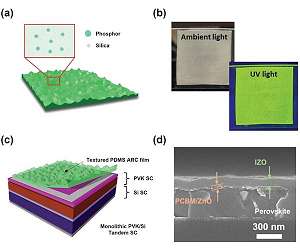To achieve climate neutrality, use of renewable energy sources must be increased massively. “Large solar parks are very important in this connection,” says Nina Munzke. The researcher at KIT’s Institute of Electrical Engineering (ETI) initiated the Solar Park 2.0 project at KIT’s Battery Technical Center.
“However, it is a problem to find larger areas for such facilities in the densely populated regions of the world. To nevertheless reach our climate goals, available areas must be used far more efficiently.” Within the Solar Park 2.0 project, researchers develop electronic components and methods for this purpose. “We want to increase the power output of photovoltaic facilities under unfavorable conditions, such as shade, dirt, or aging, and to optimize the efficiency and power yield,” Munzke says.
Increased Yields by Novel Power Electronics
To use a photovoltaic module with maximum efficiency, it has to work close to its maximum power point (MPP). “The output of the module results from the current multiplied by the voltage level. At the MPP, output is highest, meaning that the maximum possible yield is reached,” says Lukas Stefanski, ETI.
However, the MPP changes with temperature, position of the sun, and other factors. Hence, optimum operation requires the voltage to be adjusted continuously. Specialized power optimizers are applied for this purpose. Still, maximum power point tracking (MPPT) in conventional circuits mainly takes place in the central inverter.
“When several photovoltaic modules are connected in series or strings and several strings are connected in parallel, shading and failures of single modules reduce the power produced by the whole facility,” Stefanski says. “It is more advantageous to control single modules and to optimize the voltage applied to the strings depending on the specific circuitry.”
For this purpose, the HiLEM (stands for High Efficiency Low Effort MPPT) circuit patented by KIT is applied in the Solar Park 2.0 project. This circuit replaces combiner boxes that are usually applied for the parallel connection of strings and enables an efficient MPPT on the string level. Combination of a HiLEM circuit with novel power optimizers developed jointly by Karlsruhe University of Applied Sciences and the companies of BRC and PREMA then allows for simultaneous MPPT on both the string and module levels. “This does not only increase the yield of the photovoltaic facility, but also the service life. At the same time, operation costs are reduced,” Stefanski says.
Planned Test Facility on Campus North
The new optimization components are planned to be evaluated in two photovoltaic test facilities of 30 kilowatt-peak (kWp) each. One plant will be used to run test scenarios for the new power optimizers. The second plant will serve as a reference. Both plants will be set up next to each other on a free area of the existing solar park of KIT’s Energy Lab 2.0. Work will also be aimed at developing an AI-supported method to predict power production of photovoltaic facilities based on operation data.
This method will then be used to identify possibly shaded, damaged, or dirty modules. “This will help us find out at which point of solar parks installation of power optimizers would be worthwhile,” says Markus Becker from ETI. The AI is trained with long-term data from the existing solar park of Energy Lab 2.0 and data collected by the wireless monitoring system (WSN) developed by the Institute for Photovoltaics (ipv) of the University of Stuttgart.
About Solar Park 2.0
The KIT-coordinated collaboration project Solar Park 2.0 started in July 2022 and is scheduled for a duration of three years. Among the partners are Karlsruhe University of Applied Sciences and the companies BRC-Solar and PREMA Semiconductor that jointly developed the power electronics for MPPT based on application-specific integrated circuits (ASIC). ipv of the University of Stuttgart contributes its WSN system and optimizes it. The Solarwatt company helps integrate power optimizers directly in the photovoltaic modules. Solar Park 2.0 has a project volume of about EUR 3.4 million. The project is funded by the Federal Ministry for Economic Affairs and Climate Action with approximately EUR 2.5 million.
Related Links
Karlsruhe Institute of Technology
All About Solar Energy at SolarDaily.com
|
We need your help. The SpaceDaily news network continues to grow but revenues have never been harder to maintain. With the rise of Ad Blockers, and Facebook – our traditional revenue sources via quality network advertising continues to decline. And unlike so many other news sites, we don’t have a paywall – with those annoying usernames and passwords. Our news coverage takes time and effort to publish 365 days a year. If you find our news sites informative and useful then please consider becoming a regular supporter or for now make a one off contribution. |
||
|
SpaceDaily Contributor $5 Billed Once credit card or paypal |
SpaceDaily Monthly Supporter $5 Billed Monthly paypal only |
|

![]()
New study finds ways to improve light absorption in perovskite silicon tandem solar cells
Ulsan, South Korea (SPX) Oct 24, 2022
A research team, affiliated with UNIST has succeeded in achieving a power conversion efficiency (PEC) of 23.50% in a perovskite-silicon tandem solar cell built with a special textured anti-reflective coating (ARC) polymeric film. According to the research team, the PCE of the device with the ARC film was sustained for 120 hours, maintaining 91% of its initial value.
This breakthrough has been led by Professor Kyoung Jin Choi and his research team in the Department of Materials Science and Engineer … read more
